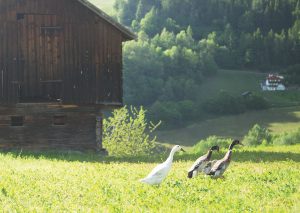For Chris Allsop, holidays in the mountains of Alto Adige have previously been adventurous sojourns with ski-safaris, Michelin-starred huts, daring hikes and near misses with ice climbing. So how would it be with the kids in tow?
Photos by Chris Allsop
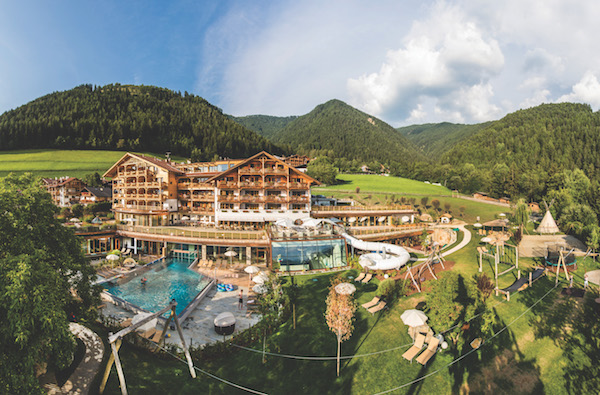
The path was narrowing. As I sweated on how the pushchair’s wheel was shaving the path’s edge, my daughter, Ada – two-and-a-quarter and trusting – reclined blithely, sucking her thumb. Dirt and pine needles cascaded down the slope to our left. I thought how fortunate it was that the hood was up, that Ada was essentially blinkered to her peril.
I’d joked to my wife earlier, on the first steep section of this panoramic hike that connected our hotel, Sonnwies, to the village of Lüsen, that this was “extreme pushchair”. Now, deep into the pine woods, it really was. Progress was becoming a serious effort. I considered turning back. Why hadn’t we chosen the hotel-provided child-backpack? Something unyielding brought the pushchair to a sudden halt.
“Look, a wild lupin.” My oblivious wife walked ahead carrying our burbling six-month-old, Rafe, on her front. The lupin spike waved in the breeze, bright as a warning.
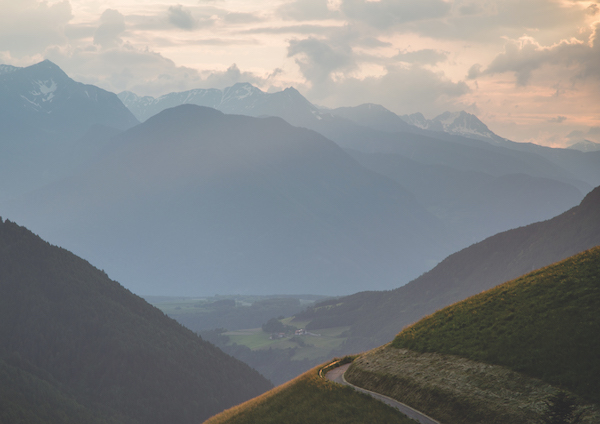
Alto Adige
I hadn’t expected our first family trip to Italy to be stress-free, but I hadn’t expected it to be quite so stressful before we even left the sofa. My wife’s passport had expired a month ago – this was discovered the afternoon before we left. That she managed to negotiate the Kafkaesque passport office and arrive at Heathrow in time for the midday flight was nothing short of miraculous. Then, a trying (though ultimately fruitful) negotiation with British Airways about their carry-on bag sizes (the issue hinged on whether it was fair to count the wheels within the bag dimensions). All this set against a night of dreadful sleep emceed by Rafe.
My previous concerns had lain with choosing the stunning Dolomites for this inaugural trip rather than an easier Tuscan-villa-with-pool holiday or Puglian beach break. I do love the Dolomites – that uniquely craggy range, the remains of an ancient seabed shared between the provinces of Trentino, Belluno, and Alto Adige. It’s supplied some of my most satisfying summer and winter breaks, whether hiking the Alta Via 1 at sunset or circumnavigating the Sella Ronda ski route with plenty of breaks for tall glasses of Moretti and sweet kaiserschmarrn. These mountains always felt like an adventure. Surely that wasn’t all behind me now I was a father of two young children?
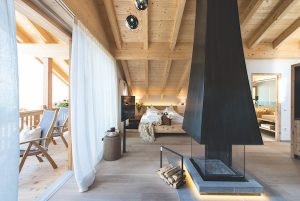
When I read about Sonnwies, I realised that it would make the perfect basecamp. This independent, family-run ‘familotel’ – as the portmanteau suggests – is designed with families in mind and located in the north of Alto Adige, that rather well-to-do autonomous province in Italy’s extreme north also known as South Tyrol. Well-situated for beginner hikes, and a short half-hour’s drive from some splendid Dolomitic scenery, the recently renovated Sonnwies also offers an organic farm, a granny-led cheesemaking demonstration – and 70 hours of free childcare. When I read about the childcare offer, the dreams of a summit-top family selfie were swiftly eclipsed by the realisation that I might be able to finish reading a novel for the first time in two and a half years.
After wiggling our way along mountain roads to the tiny hamlet in which Sonnwies sits, we could see that the hotel was everything that had been promised: essentially a high-end waterpark fused with a chalet-style hotel. There were children being led around on ponies, and extensive indoor and outdoor play areas. Watching Ada scamper off to the pony enclosure, we were lulled from our plans for an active, outdoorsy break and started to scheme as to just how much of the 70 hours we could use. Swifts danced in the mountain breezes.
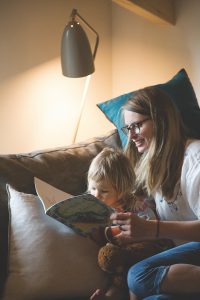
As it turned out: around five minutes. We left our eldest playing happily in the childcare area and sat uneasily outside on a bench in the adventure playground, unsure whether sidling off without saying goodbye had been the best approach. When she appeared five minutes later carried in the arms of one of the minders, it was clear that this was going to be a bona fide family holiday after all.
We spent the rest of the day unwinding in the pool area, trying out the zip lines and being seduced by the resort’s all-encompassing comfort. That night on the balcony, with the children asleep and a spectacular lightning storm enveloping the snowy peaks at the end of the valley, we sipped glasses of the local Lagrein red wine and, a little reluctantly, planned our escape.
Bressanone
Come morning, and we somehow managed to complete the faff of preparing to go out with children in time to catch the earlier of two buses at the local crossroads. Despite the bucolic location, the bus was timely and appeared to be brand new. As we wound our way towards the valley floor, the sunshine washed over the green flanks of the mountains.
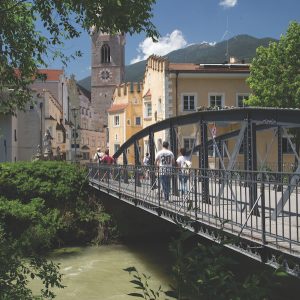
Half an hour later, and we arrived in Bressanone (aka Brixen), which would have been named only Brixen if the Austro-Hungarian Empire hadn’t ceded the province to Italy after the First World War. Whatever it was called, it felt like a real find.
Alto Adige’s third largest city after Merano/Meran and the capital Bolzano/Bozen (the latter roughly the size of Bath in population), Bressanone has a tangible history that stretches well past the Medieval era and into the dim reaches of the Mesolithic.
But it’s the Medieval you encounter first. After carefully herding Ada through the bus station and onto what appeared to be Bressanone’s busy high street, she dashed off beneath a remnant of the town’s medieval walls, zipped through a tourist tat shop (heart in throat), and emerged in a peaceful Renaissance-style rose garden named the Herrengarten, which dates back to the 16th century. Once she’d satisfied her thirst for shifting gravel from one area of the path to another, we were able to progress into Bressanone’s cathedral square.
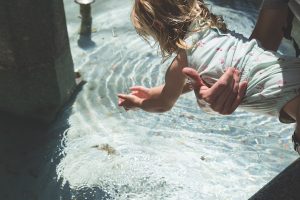
While the city is probably better known as a major ski resort (and seems purpose-built for a Christmas market), in the summer the extensive old town is a delightful place to wander, even with children. Warm, sunlight-filled squares link the bright, narrow streets, each ornamented with its own fountain, spouting – to mine and Rowena’s great relief – potable water. As we’d arrived on Saturday, a collectables market was underway – though the collectables were generally so obscure that it was clearly catering to a niche crowd.
There’s less obscure high-end boutiques also in town and, although Bressanone is the perfect size for a day-trip, I think a slow-going food and drink weekend could happily be eked out here, hopping from one grove of bright restaurant umbrellas to the next, dipping into the region’s selection of tasty white wines while watching the locals freewheel past on their well-kept classic bicycles.
The cultural takeaway to tuck into is the 10th-century cathedral’s cloister, yet another of Italy’s quietly stupendous art treasures. Stepping into the cathedral’s cool shade, the luminous glow of the extensive and well-preserved gothic frescoes is rather arresting. Even Ada slowed for a moment (although, to be fair, earlier she had stopped completely for a cone of gelato alla crema). As she dashed away again past an elderly man in a black cardigan, he made some kind of chuckling remark – in Ladin maybe – that was probably along the lines of “art lover!” or “you’ve got your work cut out.” Wearily, I gave chase.

Lüsen
Buoyed by the success of the Bressanone trip, it was decided that we should resist the siren call of the hotel’s spa and waterpark and use the next morning for an expedition into the countryside. The front desk suggested the local panoramic circuit that led down to Lüsen via a lake/lido. Perhaps due to a lack of sleep laid on by a waking-up-every-two-hours Rafe, or simply giddiness at the impressive selection of off-road buggies that the hotel had to offer, we erroneously chose a buggy over the more flexible child-backpack option.
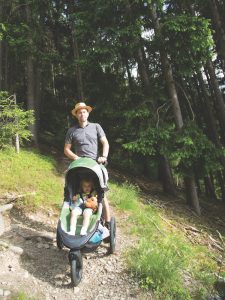
Which is how I found myself hyperventilating in the pine fresh air as what used to be a straightforward hiking prospect turned into a near-crisis. The effort of trying to manoeuvre the pushchair over the seemingly insurmountable protuberance brought on a flash of clarity: family holidays were supposed to be a matter of collaboration rather than a tyranny by parental figures unreasonably attempting to crowbar a new reality into an old pattern of being.
“Leave the lupin,” I snapped, collaboratively. “I need help.”My wife nimbly found her way back up to the pushchair and helped me lift it onto a wider stretch of path. When we eventually found the road, there was much jubilation (despite earlier dismissal of the road as the “boring” way to the lake). Ada asked if we could go faster, so I broke into a run.
When we arrived at the lake, the warm afternoon light suffused the reeds near the lake shore and glinted off the steel water slide which, although lacking the LED-assisted panache of the Sonnwies equivalent, slid you satisfactorily into the bracing water. Local children ran and dived in at the deep end while the supervisor, who was actually wearing a visor, reminded them of the time. Due to the generally poor planning of the excursion, we had only about twenty minutes at the lake/lido before it closed, but that was plenty. As we towelled Ada down, it seemed an idyllic place to grow up, and it made sense as to why the Hinteregger family who ran Sonnwies had chosen what I viewed as the hospitality hard route: catering for families. Perhaps the Hintereggers, in some way, were preserving their own childhood while in service of others’?
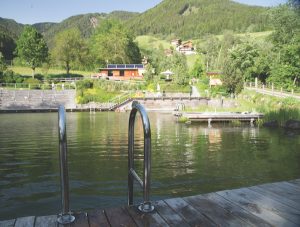
Making our way to tiny Lüsen, we found it had a nice pink church spire, a handsomely weird fresco on the fire station, and, happily for our bus back, an ATM. I extracted 50 euros while my wife held the bus. When I offered it to the driver, he laughed at the size of the bill and beckoned us on. “Sorry,” I said, re-pocketing the 50 and feeling like a huge tourist. “No,” he replied, shutting the doors. “It is my fault for not having enough change for you.”
These people, this place.
Prime Dolomites
When you are visiting the Dolomites for the first time, it’s easy to imagine that the whole area will be comprised of those skeletal mountains that burn Aperol orange in the setting sun. The area around Lüsen is generally more alpine in appearance, though travel half an hour south by car and you’ll hit the Puez-Odle Nature Park. While there are plenty of walks and areas suitable for younger children, a scenic drive through the 10,722 hectare nature park will more than satisfy your hunger for serrated peaks. Near the southern end of the park, you can also find one of Italy’s most famous ski routes, the Sellaronda loop. Connecting a number of different ski resorts, the route sticks close to the Sella massif and offers a stunning Dolomitic backdrop to a day’s skiing suitable for most levels. For more info see the Alta Badia or Süd Tirol tourism websites.
More info
Sonnwies offers rooms from €380 per night based on 2 adults and 2 children sharing on an all-inclusive basis. To book visit the website or call 
Getting there
British Airways and EasyJet fly direct to Innsbruck airport from Heathrow and Gatwick respectively. EasyJet starts from £107 per adult. By car, the transfer to Sonnwies from Innsbruck takes roughly an hour. If you take the train to Brixen, the transfer is reduced to around 15 to 20 minutes.
For more on the Dolomites click here

